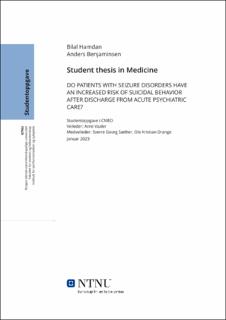DO PATIENTS WITH SEIZURE DISORDERS HAVE AN INCREASED RISK OF SUICIDAL BEHAVIOR AFTER DISCHARGE FROM ACUTE PSYCHIATRIC CARE?
Master thesis
Permanent lenke
https://hdl.handle.net/11250/3064333Utgivelsesdato
2023Metadata
Vis full innførselSamlinger
Sammendrag
BakgrunnFlere studier har blitt gjennomført i forsøk på å finne pasientpopulasjoner med økt risiko forselvmord og selvmordsatferd. Får man til å identifisere disse høyrisikopasientene, vil man kunnekomme i posisjon til å iverksette mottiltak, og forhåpentligvis redusere selvmord ogselvmordsatferd.
Vi vet at personer med anfallslidelser har høyere forekomst av selvmord og selvmordsatferdsammenlignet med kontrollgrupper. Vi vet også at den standardiserte mortalitetsratioen for suicider ca. hundre ganger høyere de to første årene etter utskrivelse hos den akuttpsykiatriskepopulasjonen (Prestmo et al., 2020). Hva med risikoen for selvmord og selvmordsatferd hospasienter med en kjent anfallslidelse som utskrives fra en akuttpsykiatrisk institusjon?Risikoen for selvmord og/eller selvmordsatferd hos pasienter med anfallslidelser i en akuttpsykiatrisk populasjon har aldri tidligere blitt forsket på. Derfor var denne studiens primæreformål å undersøke om pasienter diagnostisert med en anfallslidelse (epilepsi, akuttsymptomatisk anfall, psykogene non-epileptiske anfall) har en høyere risiko for selvmordsatferdetter utskrivelse fra en akuttpsykiatrisk avdeling sammenlignet med de andre pasientene innlagt iakuttavdelingen. Studiens sekundære formål var å undersøke om pasienter med anfallslidelserhar en økt risiko for selvmord etter utskrivelse, samt om de ulike anfallstypene var assosiert medselvmordsatferd og selvmord.
MetodeStudien ble utført ved Akuttpsykiatrisk avdeling, Østmarka, St. Olavs Hospital, Trondheim,Norge, fra september 2011 til mars 2012. Totalt 380 av 760 pasienter ga sitt skriftlige samtykketil å delta i studien.
Selvmordsatferd, definert ved ICD-10 diagnosekode X6n villet egenskade, og selvmord, bleregistrert gjennom henholdsvis fire og fem års oppfølging etter utskrivelse. Anfallslidelser bledefinert som epilepsi, akutt symptomatisk anfall og psykogene ikke-epileptiske anfall (PNES).Nevnte diagnoser ble satt i et konsensusmøte bestående av tre psykiatere og en epileptolog.Binær logistisk regresjon ble brukt for å undersøke sammenhenger mellom anfallslidelser ogselvmordsatferd, og anfallslidelser og selvmord.Resultater
Trettiåtte pasienter (10%) ble diagnostisert med en anfallslidelse. Sekstiåtte pasienter (17,9%)ble diagnostisert med X6n. Syv pasienter med anfallslidelse hadde suicidal atferd og to pasientermed anfallslidelse døde av suicid under oppfølgingstiden.I binær logistisk regresjonsanalyse forelå det ingen assosiasjon mellom anfallslidelser ogselvmordsatferd (OR [95 % Cl]: 1,424 [0,525-3,862], p = 0,488). Anfallslidelser var heller ikkeassosiert med suicid (OR [95 % Cl]: 0,721 [0,110-4,710], p = 0,732).
KonklusjonVi fant ingen statistisk signifikant sammenheng mellom anfallslidelser og selvmordsatferd ellerselvmord etter utskrivelse i en akuttpsykiatrisk populasjon. Pasienter innlagt vedakuttpsykiatriske avdelinger, også pasienter med anfallslidelser, har samtidig en høy forekomstav selvmordsatferd og selvmordsforsøk. Senere studier bør ta sikte på å inkludere flere pasienterfor å bedre kunne estimere risiko for selvmordsatferd og selvmord ved ulike typer anfallslidelser. BackgroundSeveral studies have been conducted to find groups with a higher rate of suicide and suicidalbehavior. If these groups are found, countermeasures could be provided, and hopefully loweringthe risk of suicide and suicidal behavior.
We know that people with seizure disorders have a higher occurrence of suicide and suicidalbehavior compared to control groups. We also know that the standardized mortality ratio forsuicide is approximately a hundred times higher in the first two years after discharge in the acutepsychiatric population (Prestmo et al., 2020). What about the risk of suicide and suicidalbehavior in patients with a known seizure disorder discharged from an acute psychiatricinstitution?
The risk of suicide and/or suicidal behavior in patients with seizure disorders in an acutepsychiatric population has never before been studied. Therefore, the primary aim of the studywas to investigate whether patients diagnosed with a seizure disorder (epilepsy, acutesymptomatic seizure, psychogenic non-epileptic seizures) have a higher risk of suicidal behaviorafter discharge from an acute psychiatric department compared to the other patients in thepsychiatric emergency department. The secondary aim of the study was to investigate whetherpatients with seizure disorders have an increased risk of suicide after discharge, and whether thedifferent seizure disorders were associated with suicidal behavior and suicide.
MethodThe study was conducted at the Acute Psychiatric Department, Østmarka, St. Olavs Hospital,Trondheim, Norway, from September 2011 to March 2012. A total of 380 out of 760 patientsgave their written consent to participate in the study.
Suicidal behavior, defined by ICD-10 diagnosis code X6n, intentional self-harm, and suicidewere registered during four and five years of follow-up, respectively, after discharge. Seizuredisorders were defined as epilepsy, acute symptomatic seizures, and psychogenic non-epilepticseizures (PNES). The diagnoses were made in a consensus meeting consisting of threepsychiatrists and an epileptologist.
Binary logistic regression was used to examine associations between seizure disorders andsuicidal behavior, and seizure disorders and suicide.
ResultsThirty-eight patients (10%) were diagnosed with a seizure disorder. Sixty-eight patients (17.9%)were diagnosed with X6n. Seven patients with seizure disorder had suicidal behavior and twopatients with seizure disorder died of suicide during the follow-up period.In binary logistic regression analysis, there were no association between seizure disorders andsuicidal behavior (OR [95% Cl]: 1.424 [0.525-3.862], p = 0.488). Seizure disorders were also notassociated with suicide (OR [95% Cl]: 0.721 [0.110-4.710], p = 0.732).
ConclusionWe found no statistically significant association between seizure disorders and suicidal behavioror suicide after discharge in an acute psychiatric population. Patients admitted to acutepsychiatric wards, including patients with seizure disorders, also have a high incidence ofsuicidal behavior and suicide attempts. Future studies should aim to include more patients tobetter estimate the risk of suicidal behavior and suicide in different types of seizure disorders.
